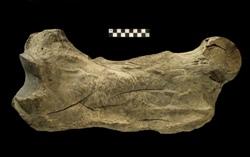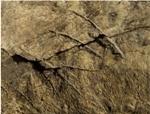Research Reveals First Evidence of Hunting by Prehistoric Ohioans
Cleveland Museum of Natural History
Source -http://www.cmnh.org/site/ResearchandCollections/Archaeology/Announcements/Sloth.aspx

Top view of the left femur (thigh bone) of an Ice Age Jefferson's Ground Sloth. Microscopic analyses of marks on the bone reveal that they were made by stone tools. The cuts indicate that humans in Ohio hunted or scavenged meat from this species earlier than previously known. This research was published in World Archaeology. © Cleveland Museum of Natural History
Cut marks found on Ice Age bones indicate that humans in Ohio hunted or scavenged animal meat earlier than previously known. Dr. Brian Redmond, curator of archaeology at The Cleveland Museum of Natural History, was lead author on research published in the Feb. 22, 2012 online issue of the journal World Archaeology.
Redmond and researchers analyzed 10 animal bones found in 1998 in the collections of the Firelands Historical Society Museum in Norwalk, Ohio. Found by society member and co-author Matthew Burr, the bones were from a Jefferson's Ground Sloth. This large plant-eating animal became extinct at the end of the Ice Age around 10,000 years ago.
"This research provides the first scientific evidence for hunting or scavenging of Ice Age sloth in North America," said Redmond. "The significant age of the remains makes them the oldest evidence of prehistoric human activity in Ohio, occurring in the Late Pleistocene period."
A series of 41 incisions appear on the animal's left femur. Radiocarbon dating of the femur bone estimates its age to be between 13,435 to 13,738 years old. Microscopic analyses of the cut marks revealed that stone tools made the marks. The pattern and location of the distinct incisions indicate the filleting of leg muscles. No traces of the use of modern, metal cutting tools were found, so the marks are not the result of damage incurred during their unearthing. Instead, the morphology of the marks reveals that they were made by sharp-edged stone flakes or blades.

A close-up view of stone tool cut marks on the lower front surface of the left femur of a Jefferson's Ground Sloth. Research published inWorld Archaeology reveals the earliest evidence of hunting by prehistoric Ohioans. © Cleveland Museum of Natural History
The "Firelands Ground Sloth," as the specimen is named, is one of only three specimens ofMegalonyx jeffersonii known from Ohio. Based on measurements of the femur, tibia and other bones, it is one of the largest individuals of this species on record. It had an estimated body mass of 1,295 kilograms (2,855 pounds).
The sloth bones were first described in a 1915 scientific paper by geologist Oliver Hay. The collection was made known to Hay by Roe Niver, a University of Illinois student who lived in Huron County and died in July 1915. The bones were donated to the Firelands Museum before 1915. The only documentation with the remains indicates they were found in a swamp in Norwich Township. The exact locality where the bones were first discovered is uncertain.
Other co-authors of the research are Dr. H. Gregory McDonald of the National Park Service and Dr. Haskel J. Greenfield of the University of Manitoba.